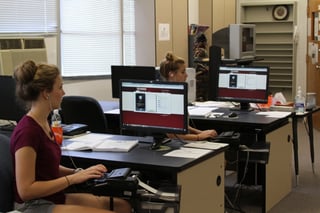
What do you want to be when you grow up? Are you detail oriented and a good listener? Do you have excellent written and verbal communication skills? Are you able to concentrate for long periods? If you answered yes to any of these questions, you might want to consider one of the options in the Court Reporting Technology program at Hinds Community College!
A career is a life plan that you will need to study for while a job is a temporary position to earn income. You don't have to decide today on your lifelong career but hopefully the information below will help you narrow down your choices and get you on the road to discovery. Take your time. Study your options and find a career that is tailored to your interests!
What are some common characteristics of successful realtime reporting students?
Court Reporting requires intelligence, dexterity and interest in a broad range of subjects. A good realtime reporter must be well versed in fields such as medicine, business, communications and technology, as well aslaw. A broadcast captioner must be able to write and perform in environments that can be quiet and controlled as well as chaotic and ever changing.
What are my career path options?
Realtime reporters are classified as Judicial Reporters, CART (Communication Access Realtime Translation) providers and Broadcast Captioners.


The following are types of career paths students with a degree from Hinds Community College Court Reporting Technology department will be qualified to explore:
- Judicial Reporters work in depositions, the courtroom and other legal proceedings providing verbatim transcription of all communication of the proceedings. They work with many lawyers and judges providing services to the criminal and civil justice system.
- Communication Access Realtime Translation (CART) providers and Broadcast Captioners provide services to the deaf and hard-of-hearing community. CART providers primarily assist deaf and hard-of-hearing individuals in classroom, business meeting and convention settings. The services of CART providers and Broadcast Captioners may be performed remotely from a home office or at an on-site location.
- Broadcast captioners provide open captions for places such as television screens and sports arenas for the deaf and hard-of-hearing.



What kind of classes are offered in the Realtime Reporting program?
- Shorthand writing principles (theory)
- Law
- Judicial
- CART and Captioning procedures
- Medical terminology
- Realtime reporting technology
- Complete internships prior to certification testing and entering the workforce
Employment potential, salaries and quick facts:
Embark on a career that’s in demand, vital, exciting and rewarding, with coast-to-coast opportunities at your fingertips. Realtime reporters can work in the legal community, provide communications access for people with hearing loss – such as providing CART or being a broadcast captioner – become an independent contractor or run their own agency.
- The U.S. Department of Labor has projected an income of $47,700 annually with 14 percent job growth through 2020.
- There are an estimated 50,000 to 60,000 court, deposition, CART and captioning reporters in the United States.
- The National Court Reporters Association reports income of $35,000 to $65,000 for these services. Spanish captioning is opening the door for more and more jobs every day to fulfill the federal mandates provided by the Telecommunications ACT of 1996.
Need More Information? This program is located on the Raymond campus of Hinds Community College. For more information on the Court Reporting Technology program, please contact Geanell Adams at 601.857.3417.


